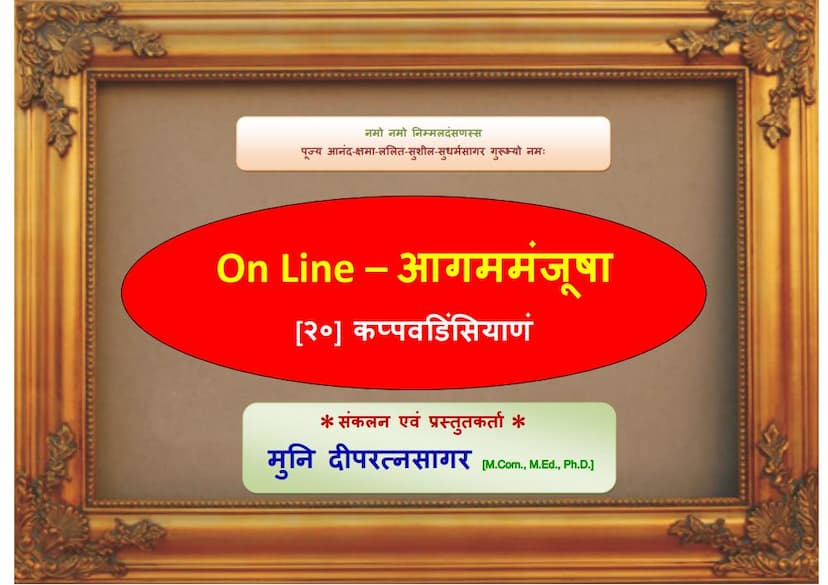Aagam Manjusha 20 Uvangsuttam Mool 09 Kappavadinsayaa
Added to library: September 1, 2025

Summary
Here's a comprehensive summary of the provided Jain text, "Aagam Manjusha 20 Uvangsuttam Mool 09 Kappavadinsayaa," based on the scanned pages:
Book and Edition Context:
- The text is part of the "Aagam Manjusha" series, a collection of Jain scriptures.
- This specific volume is the 20th in the series, focusing on "Uvangsuttam Mool 09," titled "Kappavadinsayaa."
- The original "Aagam Manjusha" was compiled about 70 years prior to 2012 (specifically in VS 1998/1942 CE) by Acharya Shri Anandasagarsuri M.S.
- This online version, "OnLine-Aagam Manjusha," is presented in 2012 CE (VS 2068/2538 VE) with some modifications:
- Avashyak Sutra (Aagam-40): Includes not just the original sutras but also the "Niyukti" (commentary/explanation).
- Jitkalpa Sutra (Aagam-38): Includes not only the original sutras but also the "Bhashya" (further commentary).
- Jitkalpa Sutra (Aagam-38) Alternate "Panchkalpa": The "Bhashya" for the alternate "Panchkalpa" is included.
- Oghninyukti (Aagam-41) Alternate "Pindninyukti": This alternate scripture is included, though its printing location has changed.
- Kalpa (Barasa) Sutra: This scripture has also been included in the original "Aagam Manjusha" compilation.
- The compiler and presenter of this online version is Muni Deepratnasagar.
Content of "Kappavadinsayaa" (Chapters 1-10):
The core of the provided text seems to be the explanation of the Kappavadinsayaa text, which is part of the Angas of Jain scriptures. The summary focuses on the content described for the first two chapters and a general overview of the subsequent ones.
-
Chapter 1 (Padmaajavanam):
- It details a narrative about a prince named Padma.
- The story begins in the city of Champa, during the reign of King Koonika and Queen Padmavati.
- Prince Padma is born to King Kuniya and Queen Kalii. His father is named Prince Kal, and his mother is Princess Padmavati.
- Upon his birth, Queen Padmavati has a dream of seeing a lion, which signifies his future greatness.
- He is named Padma.
- The text then describes his life, likely including his renunciation of worldly life.
- He learns the eleven Angas of Jainism from Lord Mahavir and his senior disciples (Theras).
- He practices austerities and eventually attains liberation (Siddhi).
- After his liberation, he is reborn as a celestial being in the Soharma heaven.
- The narrative concludes with the statement that this is the essence of the first chapter of Kappavadinsayaa.
-
Chapter 2 (Mahapadmaajavanam):
- This chapter follows a similar narrative structure.
- It concerns a prince named Mahapadma.
- The setting is again the city of Champa.
- The lineage is traced from King Kuniya and his queen, Shukaali, who has a son named Prince Sukala.
- Prince Sukala's son is named Mahapadma, and his consort is Mahapadma.
- Queen Mahapadma also has a significant dream (similar to the first chapter's description).
- The chapter likely narrates the life of Prince Mahapadma, his renunciation, spiritual pursuits, and eventual liberation.
- It mentions his rebirth in the Ishana heaven with a long lifespan.
- The essence of the second chapter is also presented.
-
Subsequent Chapters (Chapters 3-10):
- The text states that the remaining eight chapters (3 to 10) follow a similar pattern.
- The names of the protagonists in these chapters are derived from their mothers' names.
- The rebirths of these individuals are described in different heavens:
- Chapter 1: Soharma heaven.
- Chapter 2: Ishana heaven.
- Chapter 3: Sanatkumara heaven.
- Chapter 4: Mahendra heaven.
- Chapter 5: Brahma Loka heaven.
- Chapter 6: Lava Antaka heaven.
- Chapter 7: Mahashukra heaven.
- Chapter 8: Sahasrara heaven.
- Chapter 9: Pranata heaven.
- Chapter 10: Achyuta heaven.
- It is noted that they all have the highest lifespan ("utkrushtasthiti") in their respective celestial abodes.
- The text mentions that ultimate liberation (Siddhi) is attained in Mahavideha region.
- The "Kappavadinsayaa" section concludes here.
Overall Purpose:
The "Kappavadinsayaa" appears to be a narrative text within Jainism that illustrates the spiritual journey of individuals, their rebirths in various celestial realms, and their eventual attainment of liberation. The stories likely serve as exemplars of righteous conduct and the principles of Jain spiritual practice, emphasizing the consequences of actions and the path to ultimate salvation. The online compilation aims to make these important scriptures accessible with updated scholarly contributions.